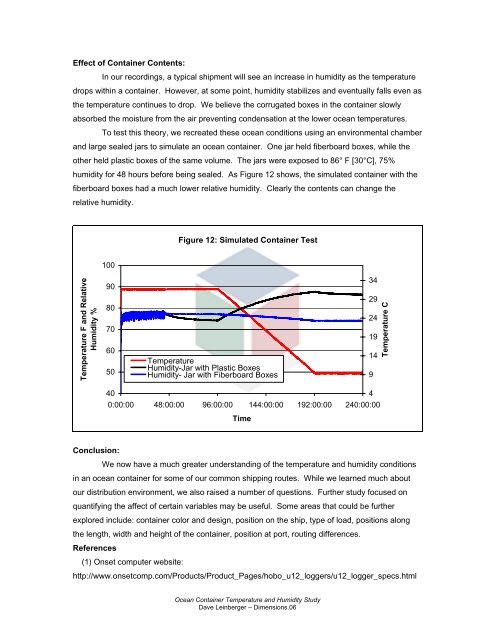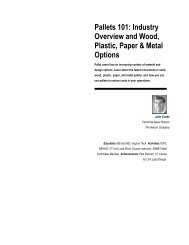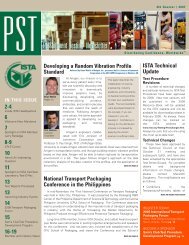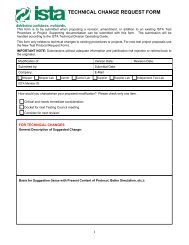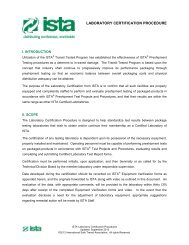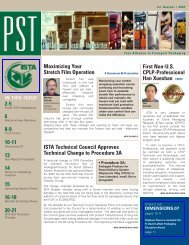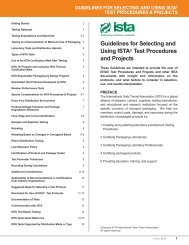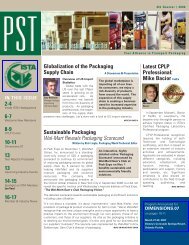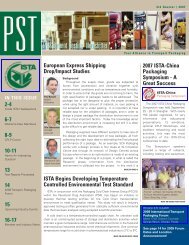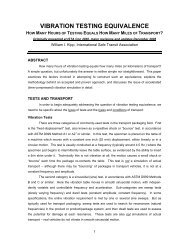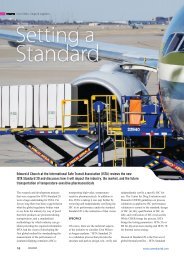Temperature & Humidity in Ocean Containers
Temperature & Humidity in Ocean Containers
Temperature & Humidity in Ocean Containers
Create successful ePaper yourself
Turn your PDF publications into a flip-book with our unique Google optimized e-Paper software.
Effect of Conta<strong>in</strong>er Contents:<br />
In our record<strong>in</strong>gs, a typical shipment will see an <strong>in</strong>crease <strong>in</strong> humidity as the temperature<br />
drops with<strong>in</strong> a conta<strong>in</strong>er. However, at some po<strong>in</strong>t, humidity stabilizes and eventually falls even as<br />
the temperature cont<strong>in</strong>ues to drop. We believe the corrugated boxes <strong>in</strong> the conta<strong>in</strong>er slowly<br />
absorbed the moisture from the air prevent<strong>in</strong>g condensation at the lower ocean temperatures.<br />
To test this theory, we recreated these ocean conditions us<strong>in</strong>g an environmental chamber<br />
and large sealed jars to simulate an ocean conta<strong>in</strong>er. One jar held fiberboard boxes, while the<br />
other held plastic boxes of the same volume. The jars were exposed to 86° F [30°C], 75%<br />
humidity for 48 hours before be<strong>in</strong>g sealed. As Figure 12 shows, the simulated conta<strong>in</strong>er with the<br />
fiberboard boxes had a much lower relative humidity. Clearly the contents can change the<br />
relative humidity.<br />
<strong>Temperature</strong> F and Relative<br />
<strong>Humidity</strong> %<br />
100<br />
90<br />
80<br />
70<br />
60<br />
50<br />
40<br />
Figure 12: Simulated Conta<strong>in</strong>er Test<br />
<strong>Temperature</strong><br />
<strong>Humidity</strong>-Jar with Plastic Boxes<br />
<strong>Humidity</strong>- Jar with Fiberboard Boxes<br />
0:00:00 48:00:00 96:00:00 144:00:00 192:00:00 240:00:00<br />
Time<br />
Conclusion:<br />
We now have a much greater understand<strong>in</strong>g of the temperature and humidity conditions<br />
<strong>in</strong> an ocean conta<strong>in</strong>er for some of our common shipp<strong>in</strong>g routes. While we learned much about<br />
our distribution environment, we also raised a number of questions. Further study focused on<br />
quantify<strong>in</strong>g the affect of certa<strong>in</strong> variables may be useful. Some areas that could be further<br />
explored <strong>in</strong>clude: conta<strong>in</strong>er color and design, position on the ship, type of load, positions along<br />
the length, width and height of the conta<strong>in</strong>er, position at port, rout<strong>in</strong>g differences.<br />
References<br />
(1) Onset computer website:<br />
http://www.onsetcomp.com/Products/Product_Pages/hobo_u12_loggers/u12_logger_specs.html<br />
<strong>Ocean</strong> Conta<strong>in</strong>er <strong>Temperature</strong> and <strong>Humidity</strong> Study<br />
Dave Le<strong>in</strong>berger – Dimensions.06<br />
34<br />
29<br />
24<br />
19<br />
14<br />
9<br />
4<br />
<strong>Temperature</strong> C


